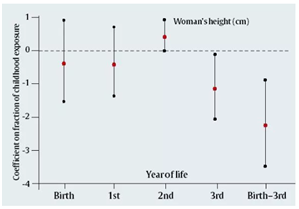

A World Bank report looks at the long-term impact of nitrate exposure experienced during infancy.
Context
A World Bank report looks at the long-term impact of nitrate exposure experienced during infancy.
About
- Nitrate pollution is caused mainly by the overuse of nitrogenous fertilisers which, while boosting yields, can be harmful if they leach into water or air.
- In India, the Green Revolution of the 1960s kick-started the use of synthetic fertilisers, the report notes.
- The data set used was taken from over 1,330 monitoring stations from 1963-2017. The birth years of the sample range was from 1966-1999, “a period when the effect of the Green Revolution was already in force yet nitrogen fertilisers were increasing in use.”
Report findings
- An infant girl who has been exposed to nitrate levels above the safety threshold in the first three years experiences a 1-2 cm decrease in her adult height.
- Given that female adult height in India has increased by approximately 4 cm over the last century, a 1-2 cm loss means that nitrate exposure in infancy can wipe out almost half of this gain in height.
- The report also found (using data from the Central Groundwater Board of India) that nitrate levels in groundwater aquifers exceeded permissible levels in more than 50 per cent of the districts across 19 states.
- The report broadly covers two types of pollutants — the well-known ones such as faecal contaminants and the new pollutants that include plastic, nutrients and pharmaceuticals.

What Is Nitrate?
Nitrate is an inorganic compound that occurs under a variety of conditions in the environment, both naturally and synthetically. Nitrate is composed of one atom of nitrogen (N) and three atoms of oxygen (O); the chemical symbol for nitrate is NO3. Nitrite (NO2) can be formed from nitrate by a chemical process called reduction. Nitrate does not normally cause health problems unless it is reduced to nitrite.
Nitrate Pollution
- Nitrate is one of the most common groundwater contaminants in rural areas. It is regulated in drinking water primarily because excess levels can cause Methaemoglobinaemia, or "blue baby" disease.
- Methemoglobinemia is the most significant health problem associated with nitrate in drinking water. Blood contains an iron-based compound called hemoglobin, which carries oxygen.
- When nitrite is present, hemoglobin can be converted to methemoglobin, which cannot carry oxygen.
- In the blood of adults, enzymes continually convert methemoglobin back to hemoglobin, and methemoglobin levels normally do not exceed 1 percent.
- Newborn infants have lower levels of these enzymes, and their methemoglobin level is usually 1 to 2 percent. Anything above that level is considered methemoglobinemia.
Infant Feeding Practices to Minimize Intake of Nitrate and Nitrite
Breast feeding: Little if any nitrate gets into breast milk, unless the mother is consuming very large quantities of nitrate. Also, bacterial contamination is not a problem when breast milk is consumed directly.
Bottle feeding: Use already diluted liquid formulas or use low-nitrate water to dilute concentrated liquid or powdered formulas. Also, mixed formulas should be kept under refrigeration and used promptly to minimize bacterial reduction of nitrate to nitrite.
Vegetables: Since many vegetables are high in nitrate, their consumption should be limited until an infant is 4-6 months old and their digestive tract has sufficiently matured. Your physician can help you decide when to add new foods. Vegetables should always be prepared while fresh and refrigerated promptly after cooking to minimize bacterial activity.

